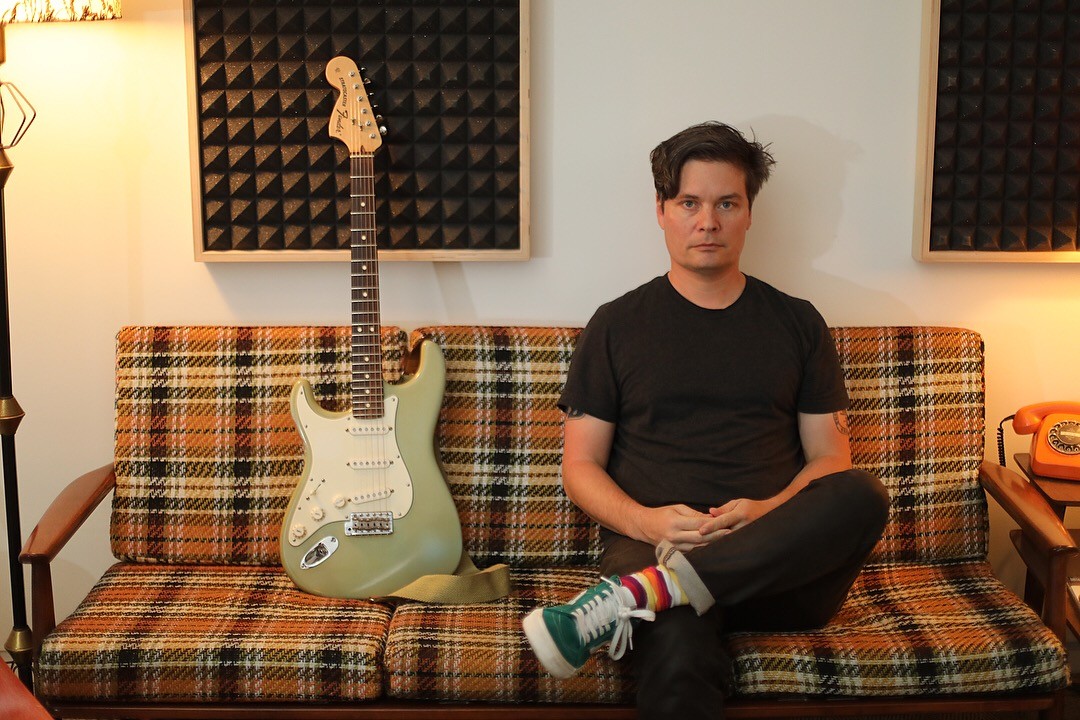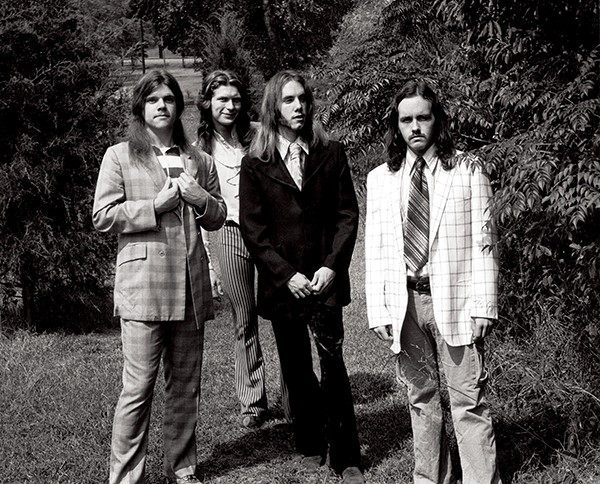
Paul Taylor, aka New Memphis Colorways
Memphians not hip to specific personnel in the local music scene may have seen the name New Memphis Colorways pop up in their feeds from time to time, and wondered just what that could be. A man? A band? A plan? [Panama? – ed.]
Actually, it’s all three. First of all, it’s the man otherwise known as Paul Taylor, a self-taught multi-instrumentalist who grew up in the midst of many Memphis music luminaries, including his own father, legendary singer and guitarist Pat Taylor. “And I learned most of my songcraft from Richard Orange,” Taylor adds. “He was very much a second dad to me.”
Orange, of course, first came to Memphis as leader of the band Zuider Zee, whose recent release of archival material from 1972-74, Zeenith, was dubbed one of 2018’s best reissues by Rolling Stone magazine. That’s especially relevant because echoes of that era, albeit with some serious reconfiguring, are all over New Memphis Colorway’s new album, The Music Stands., to be celebrated at a release party on Friday, January 31 at The Green Room at Crosstown Concourse. It will simultaneously become available on all streaming services.
“The first two tracks are my weird modern take on Memphis power pop,” says Taylor, “and then it shifts to songwriter/acoustic mode for a couple songs, and then a couple of art rock instrumentals. Then the last song is a reflective ballad.”
While it’s easy to lay claim to the territory first mapped out by Big Star, Zuider Zee, or the Hot Dogs back in the day, the proof comes as soon as the proverbial needle drops. (Someone please put this out on vinyl!) “Impossible Goals” revs up like the Clash, then hits you with unexpected riffs and the kind of unaffected, straight-arrow singing you might have thought was extinct.
One astounding feat is the way Taylor’s voice has hints of Alex Chilton, even as his songwriting has more echoes of Chris Bell. And yet the music also could sit comfortably next to much later touchstones, like the Posies, in all its unexpected harmonic and rhythmic turns.
“I don’t want to be super-referential to the past,” notes Taylor. “I hold in my head, daily, the Sam Phillips quote, ‘If you’re not doing something different, you’re not doing anything at all.’ I do make study of older music, and I think it’s critical that you learn it note for note. I’m transcribing jazz solos or learning Steve Cropper or Teenie Hodges or Reggie Young, or the drumming of Gene Chrisman and Al Jackson Jr. These are my heroes. But I don’t deliberately set about making music that shows that off. At the end of the day, I try to throw that away and just let the songs come out.”
And come out they do, as some notable musicians, having heard advance tracks, have remarked on.
“Paul Taylor’s new record, under the nom de plume New Memphis Colorways, is like looking through a glass phosphorescently. Truly an artist of wizardry, sailing uncharted waters of sound, colour and light. An otherworldly adventure in melodic transcendence. Not to be missed.” – Richard Orange
Okay, that was from his “second dad” and mentor. But other songwriters have weighed in as well. Chuck Prophet, with whom Taylor has worked extensively in the past, said, “Paul has really come into his own here. Although the songs are deceptively simple, there’s a world inside each track. These little musical creations are killer. They will creep up on you. They’ll reach out and grab you. It’s all very soulful. And a little magical too. Kinda proggy. Kind of indie. And utterly impossible to describe. I dig it.”
And one of Memphis’ more literary songwriters, Cory Branan, had this to say: “Paul’s out of his damn mind. He conjures more original musical ideas in 12 bars than most musicians do with entire albums. The Music Stands. finds him, as always, accessing strangenesses and welding the unexpected with a singular vision.”
One striking thing about the record is that it doesn’t sound, like so many records, like the product of tinkering. It has the impact of a full-on rock band. Which would seem to answer the second query as to what exactly New Memphis Colorways is. But if you assumed it was a band from, say 1979, playing on these tracks, you’d be wrong. Nearly all the instruments were played by Taylor. New Memphis Colorways is a band in a man.

“I grew up listening to a lot of Todd Rundgren and a lot of Prince, and people like that who made records where they played everything. It’s what I’ve been doing since I was literally seven years old, when my dad was helping me four-track songs, so it seemed like a natural thing for me to do. The next record I make, I would hopefully play an acoustic guitar and hire a band around me, and do it live, like a lot of Memphis records that I love were. This one is more of a D.I.Y. affair, which is fun.”
Nevertheless, the album release show will have a full band. “I have musicians that are just incredible,” says Taylor. “Hopefully we’ll be playing more shows.”
Add that to a long list of releases, projects and entities with which Taylor is associated, much of which he releases on his own label, the Owl Jackson Jr. Record Company. “New Memphis Colorways is my brand,” Taylor clarifies. “And it’s all encompassing. Anybody who knows me knows I do a bunch of different things. The EP I released previously [Old Forest Loop] was drastically different from this, and the next one will probably be drastically different.” Still other eclectic expressions come in the form of an album of experimental instrumentals that exist only under the hashtag #nmcvignettes, and an even earlier online release, The Old Forest Trail.
The diversity of these varied projects is a delight in its own right, and ultimately shows that, at heart, New Memphis Colorways is a plan. “I’m a huge fan of skateboard art and graphic design in general,” explains Taylor. “If you were to release a skateboard, it might have different color combinations and variations on the same graphic: colorways. The whole concept of New Memphis Colorways is that it’s new combinations of ideas.” In this newest work, one finds the everything-but-the-kitchen-sink approach of the ’70s alive and well, and definitely kicking. It’s an approach that suits New Memphis Colorways just fine.
 Gary Simon Bertrand
Gary Simon Bertrand 